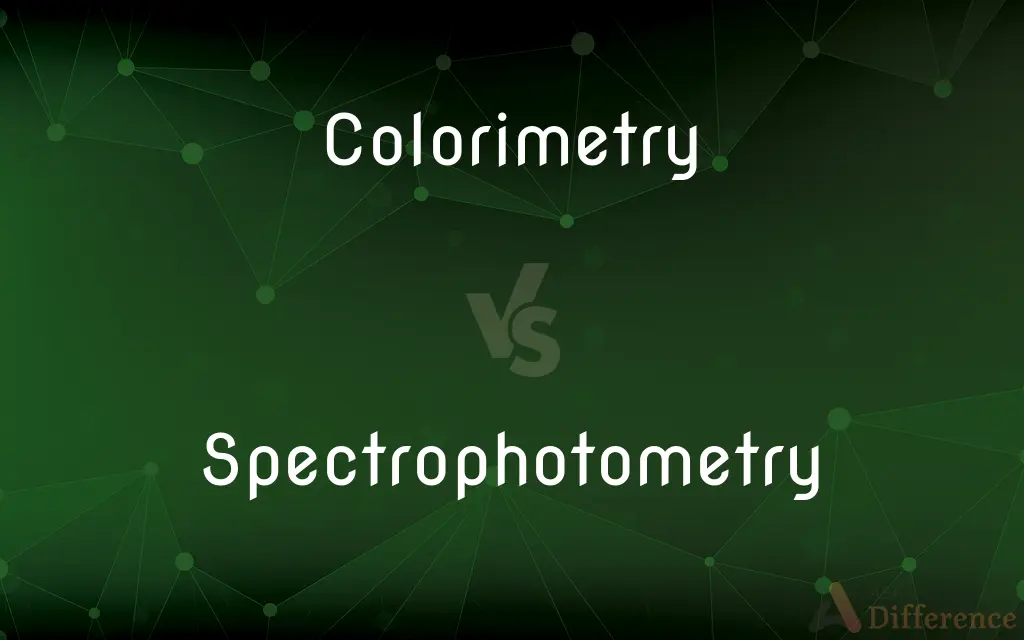Colorimetry vs. Spectrophotometry — What's the Difference?
Edited by Tayyaba Rehman — By Fiza Rafique — Updated on September 22, 2023
Colorimetry focuses on measuring the intensity of color absorbance in visible light. Spectrophotometry extends this concept by measuring the absorption of light across the entire electromagnetic spectrum.

Difference Between Colorimetry and Spectrophotometry
Table of Contents
ADVERTISEMENT
Key Differences
Colorimetry is a subset of spectrophotometry that specifically deals with the quantification of color. Spectrophotometry, however, encompasses a wider range of electromagnetic spectrum, including ultraviolet and infrared wavelengths.
In colorimetry, the analysis is generally limited to the absorption or emission of light in the visible range. Spectrophotometry, in contrast, allows for the study of a sample's interaction with light beyond just color, including its quality and concentration.
Colorimetry is often simpler and less expensive as it mainly focuses on the visible spectrum. Spectrophotometry, on the other hand, often requires more specialized equipment due to its wider range of applications.
While colorimetry is frequently used in quality control for industries like textiles and food, spectrophotometry has applications in more scientific fields such as biochemistry, physics, and environmental science.
Both colorimetry and spectrophotometry are vital techniques in various scientific disciplines. However, the choice between the two will largely depend on what exactly needs to be measured and analyzed.
ADVERTISEMENT
Comparison Chart
Spectrum Range
Visible light
Entire electromagnetic spectrum
Complexity
Simpler, fewer variables
More complex, broader variables
Equipment Required
Generally less specialized
More specialized
Applications
Textiles, food quality
Biochemistry, physics
Measured Properties
Color intensity
Light absorption, quality, concentration
Compare with Definitions
Colorimetry
Subset of spectrophotometry.
Colorimetry focuses on the visible spectrum only.
Spectrophotometry
Broad range of applications.
Spectrophotometry is used in environmental science.
Colorimetry
Analysis of absorbance in visible light.
The colorimetry test showed high levels of blue.
Spectrophotometry
Analysis extending beyond visible light.
Spectrophotometry includes ultraviolet and infrared analysis.
Colorimetry
Measurement of color intensity.
Colorimetry is used in food quality control.
Spectrophotometry
Measurement of light absorption across the spectrum.
Spectrophotometry is vital in biochemical research.
Colorimetry
Quantitative study of color.
Colorimetry helps in the textile industry.
Spectrophotometry
Requires specialized equipment.
High-precision spectrophotometry can be costly.
Colorimetry
Limited to visible spectrum.
Colorimetry doesn't involve ultraviolet light.
Spectrophotometry
Studies multiple properties of light.
Spectrophotometry measures both quality and concentration.
Colorimetry
Colorimetry is "the science and technology used to quantify and describe physically the human color perception." It is similar to spectrophotometry, but is distinguished by its interest in reducing spectra to the physical correlates of color perception, most often the CIE 1931 XYZ color space tristimulus values and related quantities.
Spectrophotometry
Spectrophotometry is a branch of electromagnetic spectroscopy concerned with the quantitative measurement of the reflection or transmission properties of a material as a function of wavelength. Spectrophotometry uses photometers, known as spectrophotometers, that can measure the intensity of a light beam at different wavelengths.
Colorimetry
Any of various instruments used to determine or specify colors, as by comparison with spectroscopic or visual standards.
Spectrophotometry
An instrument used to determine the relative intensity of various wavelengths in a spectrum of light.
Colorimetry
An instrument that measures the concentration of a known constituent of a solution by comparison with colors of standard solutions of that constituent.
Spectrophotometry
The quantitative analysis of electromagnetic spectra by use of a spectrophotometer; especially in order to determine the structure or quantity of a substance
Colorimetry
The science of measuring colours and assigning them numeric values.
Spectrophotometry
The art of comparing, photometrically, the brightness of two spectra, wave length by wave length; the use of the spectrophotometer.
Colorimetry
(analytical chemistry) Analysis involving the quantitative measurement of colour.
Spectrophotometry
The art or process of measuring the degree of absorption of light at different wavelengths by a chemical substance, by means of a spectrometer or spectrophotometer. It is a technique for chemical analysis.
Colorimetry
The quantitative determination of the depth of color of a substance.
Colorimetry
A method of quantitative chemical analysis based upon the comparison of the depth of color of a solution with that of a standard liquid.
Colorimetry
Quantitative chemical analysis by color using a colorimeter
Common Curiosities
What are some uses of spectrophotometry?
It's used in biochemistry, physics, and environmental science.
Is colorimetry part of spectrophotometry?
Yes, it's a subset focusing on visible light.
Is colorimetry cheaper?
Generally, due to its limited scope.
What kind of light does spectrophotometry study?
The entire electromagnetic spectrum.
Is colorimetry less complex?
Generally, because of its narrow focus.
Does spectrophotometry require special equipment?
Usually, due to its broader range.
What does colorimetry mainly measure?
Color intensity in the visible spectrum.
Can colorimetry be used in science?
Yes, but its applications are more limited.
Can colorimetry measure UV light?
No, it's limited to the visible spectrum.
Is spectrophotometry always necessary?
Not always; if focus is on color, colorimetry may suffice.
Is colorimetry qualitative or quantitative?
It's mainly quantitative.
Can spectrophotometry measure color?
Yes, but it also extends beyond color measurement.
Can colorimetry and spectrophotometry be used together?
Yes, depending on the scope of the study.
What is the key advantage of spectrophotometry?
Its versatility and broad applicability.
What elements can spectrophotometry analyze?
Quality, concentration, and absorption of light.
Share Your Discovery

Previous Comparison
Compensation vs. Payroll
Next Comparison
Executive vs. EmployeeAuthor Spotlight
Written by
Fiza RafiqueFiza Rafique is a skilled content writer at AskDifference.com, where she meticulously refines and enhances written pieces. Drawing from her vast editorial expertise, Fiza ensures clarity, accuracy, and precision in every article. Passionate about language, she continually seeks to elevate the quality of content for readers worldwide.
Edited by
Tayyaba RehmanTayyaba Rehman is a distinguished writer, currently serving as a primary contributor to askdifference.com. As a researcher in semantics and etymology, Tayyaba's passion for the complexity of languages and their distinctions has found a perfect home on the platform. Tayyaba delves into the intricacies of language, distinguishing between commonly confused words and phrases, thereby providing clarity for readers worldwide.














































